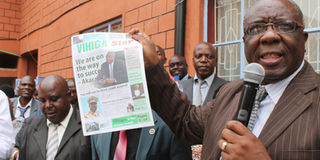County-owned media such a bad idea

Vihiga Governor Moses Akaranga displaying a copy of Vihiga Star a weekly county newspaper. County governments have been ordered to stop any construction on roads classified as class D, which had previously been devolved after deliberations between governors and the President. PHOTO | ISAAC WALE
What you need to know:
- Vihiga Governor Moses Akaranga, for example, while announcing the setting up of an FM station in addition to Vihiga Star, a bi-weekly publication already in existence, said in June the media outlets will help residents make good decisions.
- The government publishes 11 rural newspapers ranging from Sauti ya Pwani covering the coastal region to Nyota ya Magharibi covering the western region.
Six county governments — Nairobi, Vihiga, Kwale, Meru, and Elgeyo Marakwet — have so far announced plans to establish their own radio, television, magazines, and newspapers, which will cost billions of shillings. Other counties are expected to follow.
But that’s not the best way of utilising scarce development funds. In all likelihood, experience shows, those publishing ventures will end up as one sorry mess and a misallocation of resources.
A county government-owned and controlled media will most likely be His Master’s Voice (HMV). The master, in this case, will be the governor. HMV will only benefit the master and his political cronies, not the citizens.
HMV will not be able to watchdog the county government. HMV will be a return to the old KBC and Voice of Kenya days when the President was the news and the news was the President (now read the governor).
HMV will be a negation of the media as the Fourth Estate, whose role is to check on the other arms of government. HMV will not be able to check on the County Executive, abuse of office, official corruption, and wrongdoing. HMV will be the propaganda arm of the Governor’s Office, the lap dog for the County Assembly, or both.
VIHIGA STAR
The governors seeking to set up the media empires have argued they need their own media to facilitate public participation in county affairs. Vihiga Governor Moses Akaranga, for example, while announcing the setting up of an FM station in addition to Vihiga Star, a bi-weekly publication already in existence, said in June the media outlets will help residents make good decisions.
“An enlightened society will be in a good position to make informed choices. This will also enhance information flow within the county,” he said.
Others have spoken in similarly plausible terms. But history teaches us that government-owned and controlled media is not the best proposition for keeping citizens well informed. The best proposition is an independent (private) media.
At any rate, there’s no absence of media in the counties. In fact, there’s a proliferation. Every major community has a vernacular radio. Some have more than one. There are, at the last count, over 100 radio stations ranging from Lake Victoria FM to Bahari FM.
NATIONAL REACH
There are also close to 10 TV stations with a national reach while over 100 TV broadcast licences have been issued to over 40 companies.
The government publishes 11 rural newspapers ranging from Sauti ya Pwani covering the coastal region to Nyota ya Magharibi covering the western region. Journalists and other entrepreneurs have also set up newspapers in counties including Mombasa, Kilifi, Trans Nzoia, Laikipia, Nyeri, Meru, Kajiado, Machakos, Taita-Taveta, Nyeri, Nakuru, and Migori.
If the governors truly want to promote the free flow of news, information, and ideas in their counties the best thing is to support these entrepreneurs by providing them with an enabling environment including free access to official information, as well as advertising support. HMV is not a viable option.





